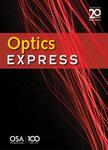版权所有:内蒙古大学图书馆 技术提供:维普资讯• 智图
内蒙古自治区呼和浩特市赛罕区大学西街235号 邮编: 010021

作者机构:Univ Sao Paulo Inst Fis Sao Carlos BR-13560970 Sao Carlos SP Brazil Univ Fed Goias Inst Fis BR-74001970 Goiania Go Brazil Univ Sao Paulo FFLCRP Dept Fis & Matemat BR-1404090 Ribeirao Preto SP Brazil
出 版 物:《OPTICS EXPRESS》 (Opt. Express)
年 卷 期:2011年第19卷第11期
页 面:10813-10823页
核心收录:
学科分类:070207[理学-光学] 07[理学] 08[工学] 0803[工学-光学工程] 0702[理学-物理学]
基 金:Fundacao de Amparo a Pesquisa do Estado de Sao Paulo Conselho Nacional de Desenvolvimento Cientifico e Tecnologico
主 题:Laser operation Nonlinear absorption Organic light emitting diodes Photodynamic therapy Picosecond pulses Pulsed operation
摘 要:We report on a method to study the dynamics of triplet formation based on the fluorescence signal produced by a pulse train. Basically, the pulse train acts as sequential pump-probe pulses that precisely map the excited-state dynamics in the long time scale. This allows characterizing those processes that affect the population evolution of the first excited singlet state, whose decay gives rise to the fluorescence. The technique was proven to be valuable to measure parameters of triplet formation in organic molecules. Additionally, this single beam technique has the advantages of simplicity, low noise and background-free signal detection. (C) 2011 Optical Society of America